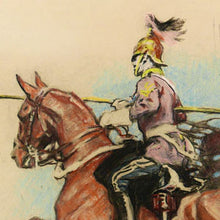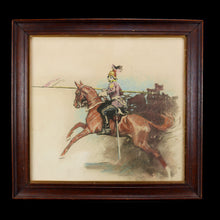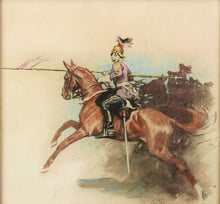3rd Carabiniers (Prince of Wales's Dragoon Guards) - Skill-at-Arms, 1910
Adding product to your cart
Overall: 56cm (22in) x 59cm (23.2in)
Pastel on paper. Equestrian study of a corporal dressed and equipped for a skill-at-arms competition of the type performed at Aldershot before the First World War. Such events included tent-pegging with the lance, ’cutting lemons’ with swords and ‘The Victoria Cross Race’ in which several riders attempted to pick up a ‘fallen comrade’. Image size: 45cm (17.7in) x 48cm (19in). Signed 'G.H.’ lower right. Contained in a period oak frame with gilt slip. Glazed.
Read more
Charles Gilbert Joseph Holiday (1879-1937) was the son of a Sir Frederick Holiday, auditor of the India Office. His mother, Adelia, was a watercolourist and his uncle, Henry Holiday, a well-known stained glass designer. Known as Gilbert or simply ‘GH’, Holiday’s work has been compared with that of Munnings and was admired by contemporary equestrian artists C.J. Payne (‘Snaffles’) and Lionel Edwards. Edwards said of him no one could paint a horse in action better than Gilbert. Gilbert was born in London and grew up in Carlton Vale close to St John’s Wood Barracks, then home of the Royal Horse Artillery. He studied at the Royal Academy Schools and later went on to work as an illustrator for The Graphic, Tatler and Illustrated London News. Holiday volunteered soon after the outbreak of war in 1914, and, claiming he was under 30 when actually 35 years old, was commissioned into the Royal Field Artillery, seeing action at Arras, Passchendaele and the Third Battle of Ypres. He continued sketching throughout the war producing many atmospheric and moving drawings. After the war he illustrated the Royal Artillery Commemoration Book and received commissions from several regiments and corps. He became widely known for his paintings of The Grand National and other major race meetings as well as the posters for the Royal Tournament. A fall whilst out hunting with the Woolwich Drag in 1932 shortened his life. He crushed his spinal cord and never walked again but with considerable courage he continued painting until his death in January 1937 at the age of 57.






